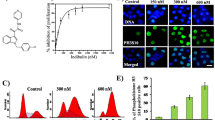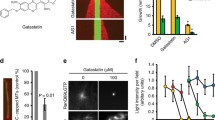Abstract
Estramustine phosphate (EMP) is an anti-microtubule agent that depolymerizes microtubules and also causes apoptosis of glioma cells. Both of these pharmacological actions have been previously studied within the same cytotoxic range of EMP concentrations. The purpose of this study was to investigate which of these two phenomena occurred before the other. A preliminary MTT assay was done to distinguish non-cytotoxic (0.005–0.1 μM) and cytotoxic (0.5–10 μM) of EMP for BT4C cells. To investigate apoptotic changes, transmission electron microscopy (TEM), DNA laddering, and in situ endo-labeling (TUNEL) method were employed. A chemotaxis assay was used to assess cell motility. Scanning electron microscopy and TEM immunocytochemistry with an anti-β tubulin antibody were applied to detect morphological changes of the microtubules. Suppression of cell motility by cytotoxic doses of EMP (0.5–10 μM) group was attributed by the cyto-reductive effect, relating to apoptosis. At 0.01–0.1 μM (non-cytotoxic doses), EMP did not indue apoptosis. At these concentrations, TEM and immunohistochemistry revealed the formation of blebs on the tip of the pseudopodia that contained abnormally depolymerized microtubules, a finding that was not observed at a low temperature or during cell migration. Cell chemotaxis was significantly inhibited by cytostatic EMP doses (0.05 and 0.1 μM). Bleb formation of the pseudopodia might be evidence of the abnormal disassembly of microtubules by cytostatic EMP concentrations, prior to the induction of apoptosis. In glioma cells EMP probably initiates apoptosis by causing the depolymerization of microtubules. Inhibition of cell motility by cytostatic doses of EMP could be beneficial to support other therapies.
Similar content being viewed by others
References
Kanje M, Deinum J, Wallin M, Ekstrom P, Edstrom A, Hartley-Asp B: Effect of estramustine phosphate on the assembly of isolated bovine brain microtubules and fast axon transport in the frog sciatic nerve. Cancer Res 45: 2234–2239, 1985
Kim JH, Khil MS, Ryu S, Gabel M: Clinical and biological studies of estramustine phosphate as a radiation sensitizer. Int J Radiat Oncol Biol Phys 29: 555–557, 1994
Forsgren B, Björk P: Specific binding of estramustine to prostatic proteins. J Urol 23: 31–38, 1984
Gunnarsson PO, Andersson SB, Sandberg AA, Ellman M: Accumulation of estramustine and estromustine in adipose tissue of rats and humans. Cancer Chemother Pharmacol 28: 361–364, 1991
Bergenheim AT, Gunnarsson PO, Edman K, Schoultz Ev, Hariz M: Uptake and retension of estramustine and presence of estramustine binding protein in malignant brain tumours in humans. Br J Cancer 67: 358–361, 1993
Bergenheim AT, Bjork P, Bergh J, von-Schoultz E, Svedberg H, Henriksson R: Estramustine-binding and specific binding protein of the anti-mitotic compound estramustine in astrocytoma. Cancer Res 54: 4974–4979, 1994
Johansson M, Bergenheim A, D'Argy R, Edman K, Gunnarsson P, Wildmark A, Henriksson R: Distribution of estramustine in the BT4C rat glioma model. Cancer Chemother Pharmacol 41: 317–325, 1998
von-Shoultz E, Begenheim T, Grankvist K, Henriksson R: Estramustine binding protein in human brain-tumor tissue. J Neurosurg 74: 962–964, 1991
Behnam-Motlagh P, Jonsson O, Engstrom K, Henriksson R, Grankvist K: Computerized detection of morphological changes to glioma cells during estramustine and ion-channel blocker perifusion. Br J Cancer 76: 318–324, 1997
Yoshida D, Cornell-Bell A, Piepmeier JM: Selective antimitotic effects of estramustine correlate with its antimicrotubule properties on glioblastoma and astrocytes. Neurosurgery 34: 863–868, 1994
Johansson M, Bergenheim A, Widmark A, Henriksson R: Effects of radiotherapy and estramustine on the microvasculature in malignant glioma. Br J Cancer 80: 142–148, 1999
Ryu S, Gabel M, Khil MS, Lee YJ, Kim SH, Kim JH: Estramustine: a novel radiation enhancer in human carcinoma cells. Int J Radiat Oncol Biol Phys 30: 99–104, 1994
Yoshida D, Piepmeier JM, Weinstein M: Estramustine sensitizes human glioblastoma cells to irradiation. Cancer Res 54: 1415–1417, 1994
Piepmeier JM, Keefe DL, Weinstein MA, Yoshida D, Zielinski J, Lin TT, Chen Z, Naftolin F: Estramustine and estrone analogs rapidly and reversibly inhibit deoxyribonucleic acid synthesis and alter morphology in cultured human glioblastoma cells. Neurosurgery 32: 422–431, 1993
Bergenheim A, Henriksson R, Piepmeier JM, Yoshida D: Estramustine in malignant glioma. J Neuro-Oncol 30: 81–89, 1996
Bergenheim A, Henriksson R: Pharmacokinetics and pharmacodynamics of estramustine phosphate (Review). Clinical Pharmacokinetics 34: 163–172, 1998
Pedrotti B, Islam K: Estramustine phosphate but not estramustine inhibits the interaction of microtubule associated protein 2 (MAP2) with actin filaments. FEBS Lett 403: 123–126, 1997
Vallbo C, Bergenheim A, Bergh A, Grankvist K, Henriksson R: DNA fragmentation induced by the antimitotic drug estramustine in malignant rat glioma but not in normal brain - suggesting an apoptotic cell death. Br J Cancer 71: 717–720, 1995
Yoshida D, Shimura T, Takahashi H, Hoshino S, Aihara K, Teramoto A: Drug-induced apoptosis by antimicrotubule agent, estramustine phosphate on human malignant glioma cell line, U87MG; in vitro study. J Neuro-Oncol 47: 133–140, 2000.
Haldar S, Chintappalli J, Croce CM: Taxol induces Bcl-2 phosphorylation and death of prostate cancer cells. Cancer Res 56: 1253–1255, 1996
Kondoh M, Usui T, Nishikiori T, Mayumi T, Osada H: Apoptosis induction via microtubule disassembly by an antitumor compound, pironectin. Biochem J 340: 411–416, 1999
Engstrom KG, Grankvist K, Henriksson R: Early morphological detection of estramustine cytotoxity measured as alteration in cell size and shape by a new technique of microperifusion. Eur J Cancer 27: 1288–1295, 1991
Panda D, Miller H, Islam K, Wilson L: Stabilization of microtubule dynamics by estramustine by binding to a novel site in tubulin: a possible mechanistic basis for its antitumor action. Proc Natl Acad Sci USA 94: 10,560–10,564, 1997
Piepmeier J, Pedersen P, Yoshida D, Greer C: Targeting microtubule-associated proteins in glioblastoma: a new strategy fro selective therapy. Ann Surg Oncol 3: 543–549, 1996
Yoshida D, Piepmeier J, Bergenheim A, Henriksson R, Teramoto A: Suppression of matrix metalloproteinase-2-mediated cell invasion in U87MG, human glioma cells by anti-microtubule agent; in vitro study. Br J Cancer 77: 21–25, 1998
Fisher D: Apoptosis in cancer therapy. Cell 78: 539–542, 1994
Motyl T: Regulation of apoptosis: involvement of Bcl-2-related proteins. Reprod Nutr Dev 39: 49–59, 1999
Nikkahah G, Tonn J, Hoffmann O, Kraemer H, Darling J, Schonmayr R, Schachenmayr W: The MTT assay for chemosensitivity testing of human tumors of the central nervous system. J Neuro-Oncol 13: 1–11, 1992
Giese A, Rief M, Loo M, Berens M: Determinants of human astrocytoma migration. Cancer Res 54: 3897–3904, 1994
Muir D, Sukhu L, Johnson J, Lahorra M, Maria B: Quantitative methods for scoring cell migration and invasion in filter-based assays. Anal Biochem 215: 104–109, 1993
Lin CH, Forscher P: Cytoskeleton remodeling during growth cone-target interactions. J Cell Biol 121: 1369–1383, 1993
Singh S, Gao Y, Singh L, Kunapuli S, Ravindra R: Role of microtubules in glucose uptake by C6 glioma cell. Pharmacol Toxicol 83: 83–89, 1998
McGuire W, Rownski E, Rosenshein N, Grumbie F, Ettinger D, Armstrong D, Donehower R: Taxol: a unique antineoplastic agent with significant activity in advanced ovarian epithelial neoplasms. Ann Int Med 111: 273–279, 1989
Weller M, Trepel M, Grimmel C, Schabet M, Bremen D, Krajewski S, Reed J: Hypericin-induced apoptosis of human maligant gloma cells is light-dependent, independent of Bcl-2 expression, and does not require wild-type p53. Neurog Res 19: 459–470, 1997
Woods C, Zhu J, McQueney P, Bollag D, Lazarides E: Taxol-induced mitotic block triggers rapid onset of a p53-independent apoptotic pathway. Mol Med 1: 506–526, 1995
Yoshida D, Piepmeier JM, Teramoto A: In vitro inhibition of cell proliferation, viability, and invasiveness in U87MG human glioblastoma cells by estramustine phosphate. Neurosurgery 39: 360–366, 1996
Sahenk Z, Mendell J: Alteration in slow transport kinetics induced by estramustine, an agent binding to microtubule-associated proteins. J Neurosci Res 32: 481–493, 1992
Santell L, Marotti K, Bartfeld N, Baynham P, Levin E: Disruption of microtubules inhibits the stimulation of tissue plasminogen activator expression and promotes plasminogen activator inhibitor type 1 expression in human endothelial cells. Exp Cell Res 201: 358–365, 1992
Mohanam S, Sawaya R, McCutcheon I, Ali-Osman F, Boyd D, Rao J: Modulation of in vitro of human glioblastoma cells by urokinase-type plasminogen activator receptor antibody. Cancer Res 53: 4143–4147, 1993
Johansson M, Bergenheim A, Henriksson R, Koskinen L, Vallbo C, Wildmark A: Tumor blood flow and the cytotoxic effects of estramustine and its constituents in a rat glioma model. Neurosurgery 41: 237–244, 1997
Author information
Authors and Affiliations
Rights and permissions
About this article
Cite this article
Yoshida, D., Noha, M., Watanabe, K. et al. The Bleb Formation of the Extracellular Pseudopodia; Early Evidence Of Microtubule Depolymerization by Estramustine Phosphate in Glioma Cell; In Vitro Study. J Neurooncol 52, 37–47 (2001). https://doi.org/10.1023/A:1010653613588
Issue Date:
DOI: https://doi.org/10.1023/A:1010653613588




